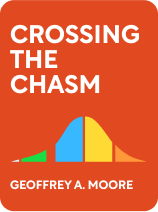

This article is an excerpt from the Shortform book guide to "Crossing the Chasm" by Geoffrey Moore. Shortform has the world's best summaries and analyses of books you should be reading.
Like this article? Sign up for a free trial here .
What exactly is a “whole product”? Why is it important that you deliver the whole product to your customers?
When you make a sale, you’re typically only obligated to deliver the core product. However, while innovators and early adopters are usually willing to take ownership of assembling the whole product for themselves, the early majority are not. If you fail to supply the whole product (a complete solution without native or third-party add-ons), you are risking losing those customers.
In this article, we’ll take a look at two whole product models: Theodore Levitt’s Whole Product Model and Geoffrey Moore’s Simplified Whole Product Model.
Levitt’s Whole Product Model
Once you have identified a target customer who has a compelling problem your product can solve, you need to make sure your target customer can buy the complete solution—that is, the whole product. In Theodore Levitt’s “Whole Product Model”, a whole product is composed of four elements: 1) generic product, 2) expected product, 3) augmented product, and 4) potential product.
- The center ring is labeled the “generic product,” and represents the core technology, or the core product that you produce.
- The next circle represents the “expected product,” or the solution that your customer expects to get once your product is set up.
- The third circle is called the “augmented product,” which represents the maximum capabilities of the product when combined with existing third-party add-ons.
- The outer circle represents the “potential product,” and represents the maximum capabilities of the system when combined with addons that could potentially be developed in the future.
Moore then introduces his own “Simplified Whole Product Model,” which focuses just on the elements of the whole product model that are relevant to crossing the chasm. Specifically, he leaves out augmented or potential products, which you won’t be concerned with when introducing a new technology. We’ll discuss Moore’s simplified whole product model next.
Geoffrey Moore’s Simplified Whole Product Model
(Shortform note: Like Levitt, Moore refers to the core product as the “generic product.” Today, however, the term “generic product” has come to mean an un-branded low-priced alternative, so to avoid confusion, we will use the term “core product” in place of Moore’s “generic product.”)
Moore presents his “simplified whole product model” as a pair of concentric circles with the outer ring divided into sectors, as shown below. The center represents the core product, and each sector represents one of the interfacing products or services that you add to it to assemble the whole product. Because of its shape, Moore also refers to this figure as a “donut diagram.”
For example, if the core product is a smartphone, one sector would be electricity to charge the phone, another would be the operating system that runs on the phone, and another would be a data plan from a phone service provider.
Shortform Commentary: Implications of Moore’s Sectors on the Whole Product Model
To derive Moore’s simplified whole-product model from Levitt’s whole product model, you first eliminate the outer two rings, leaving only the “generic” product in the center, surrounded by the “expected” or “whole” product. You then divide the remaining outer ring into sectors, reflecting the different interfaces or complementary products or services that your customer must have in order to make your product work.
If we were to add the third ring, the augmented ring, back into this model, the augmented ring could no longer be represented by a continuous circle—any additional products or services that would fall into the augmented circle would interface with only certain segments of the second, the expected, ring.
For example, if the core product is a smartphone, its second ring might include an operating system, wifi capabilities, a camera, and a headphone jack. Its third ring might contain a wireless security system, consisting of cameras that would interface with the phone through wifi, and an app running on the phone’s operating system, but would not interface, for example, with the phone’s headphone jack. We might therefore end up with a diagram that looks more like this:
Why Whole Products Matter
Moore notes that when you make a sale, you’re typically only obligated to deliver the core product. However, while innovators and early adopters are usually willing to take ownership of assembling the whole product for themselves, the early majority are not. As Moore points out, if you don’t arrange for the whole product to be supplied, you’re taking a serious risk: If your customer can’t get the whole product set up easily, they may feel cheated. Moreover, because early-majority customers are sensitive to reputations, one dissatisfied customer who tarnishes your product’s reputation can have a devastating effect on your sales.
(Shortform note: Regis McKenna also echoes this warning, in his book The Regis Touch, asserting that a customer who is impressed with your product will likely tell two or three other people about it, but a customer who is disappointed will probably vent his disillusionment to about 10 other people.)
How to Identify Your Whole Product
To identify your whole product, Moore advises that you draw a “donut diagram,” and label the sectors with everything that your product depends on or has to interact with in order to solve your target customer’s problem. For example, does it need electricity, fuel, or wifi? Does it need to “talk” to other software or machines?
Depending on how they intend to use your product, different customers may need different whole products. Thus, Moore advises that you focus only on the niche application of your chosen target customer. This allows you to keep the whole product as simple as possible, since you don’t have the resources to supply a whole product for every conceivable application.
For example, suppose your company has developed a new type of camera sensor with ground-breaking low-light image quality. You could design a security camera system around your core technology and market it to department stores. In this case, to deploy your system effectively, your customers will want to network a large number of cameras, and they’ll want advanced software features like automatic object-removal detection to help them catch shoplifters. On the other hand, if you select homeowners as the target customer for your security cameras, they’ll need a very simple installation procedure, and will probably want the system to interface with a phone app so they can view the camera feed remotely when they’re not home. Thus, your cameras will need to interact with different networking equipment and monitoring software depending on whether you target the commercial surveillance market or the home surveillance market. This, in turn, could affect which companies you need to partner with to supply a whole product.
Determine How the Rest of the Whole Product Will Be Supplied
Once you’ve identified every component of your whole product, and listed it on your donut diagram, you need to figure out how to supply each of those components. Based on Moore’s observations, there are essentially three possibilities:
- In some cases, the interfacing product or service is readily available, and the risk of the customer struggling with setup is low. For example, if your product uses 120V AC electricity, your customer can just plug it into an electrical outlet.
- Some interfaces may be specialized enough to warrant supplying the component yourself and bundling it with your product. For example, most smartphones ship with the operating system already installed.
- Finally, you may be able to partner with another company that will deliver part of the whole solution. For example, maybe you want to deploy a hydrogen-powered car, and you coordinate with another company that can supply hydrogen fuel to set up fueling stations for your customers.
(Shortform note: When Moore stresses the importance of making sure the whole product is readily available, and discusses the above options, he doesn’t explicitly compare and contrast the benefits of each method. However, he spends much of the chapter talking about how to manage corporate alliances, implying that he considers partnerships a particularly important method or resource for supplying the whole product.)

———End of Preview———
Like what you just read? Read the rest of the world's best book summary and analysis of Geoffrey Moore's "Crossing the Chasm" at Shortform .
Here's what you'll find in our full Crossing the Chasm summary :
- An explanation of the chasm phenomenon that many new high-tech products face
- How to pilot a product across this chasm to mainstream success
- The problems with the Technology Adoption Life Cycle (TALC) model






